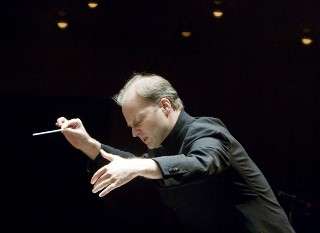|
Back
A Pair of Fives New York
Carnegie Hall
05/30/2018 -
Wolfgang Amadeus Mozart: Violin Concerto No. 5 in A major K. 219, “Turkish”
Gustav Mahler: Symphony No. 5
James Ehnes (violin)
The MET Orchestra, Gianandrea Noseda (conductor)

G. Noseda
“Growing up we thought that everyone had a harp in the house.”
William Saroyan, The Human Comedy
“...a sunset landscape at harvest time.”
Rudolph Kastner, Münchner Neueste Nachrichten
“What should they make of these primeval noises this rushing, roaring, raging sea, these dancing stars, these ebbing, shimmering, gleaming waves? What can a herd of sheep answer to an ancient lay ‘mid-brother spheres’ other than bleat?”
Mahler to Alma, October 1904
An interesting pairing was featured at Carnegie Hall last evening and began with Mozart. Unfortunately, the balance of the presentation was off from the beginning. Poor James Ehnes was asked not to be a part of the elephantine ensemble but rather challenged to be heard at all over its roar. I tend to write little notes to myself at these proceedings and during this struggle between fiddle and titanic hurricane I scribbled:
Orch 2 big
At intermission we joined friends from Holland, one of whom stating that the proportion was off. I showed her my note.
After the failure of the Fourth Symphony, Mahler consciously began to compose in a new style. His next three symphonies are more conventional in form and instrumentation (there is no singing whatsoever) and his influences reached back to Art of the Fugue of Bach and the vicarious relearning of basic composition that he accomplished with his sweetheart and soon-to-be wife, Alma Schindler, who was at the time a composition student of Alexander von Zemlinsky. The Fifth Symphony, whose only peccadillo is its five movement “bridge structure”, is in many ways the most mainstream of all of Mahler’s works. He writes a false beginning to a concerto-like movement when he fashions the middle of his bridge as an ersatz concertante piece for horn and orchestra. The third movement is a full-fledged horn concerto (actually the “solo” part is shared by two different horns) that is constructed as an obbligato and, after a movement only for strings and harp, the horn proclaims in a fanfare that the concerto will return. It does not. At this moment the horn represents a flash of instantaneously lost memory.
This performance was rather surprisingly disappointing. The funeral march first movement was competent but the phrasing could have been quite a bit more Danubian. A fine transition ushered in the best performance of the evening, the second movement giving us hope that the first had simply been an aberration. Alas, this was not the case.
The slow section of the “horn concerto” was extremely well phrased, but other parts, especially towards the conclusion, were oddly sparse and stark – not what Mahler had intended. The final “Rheingold” fanfare was well placed and well played but was hardly enough to save the day completely.
Just recently my friend Jay Nordlinger invited Noseda onto his podcast where one of many topics that they discussed was Mahler’s designation of the fourth movement – the one composed only for strings and harp – as an Adagietto as opposed to an Adagio. Maestro astutely suggested that this diminutive indicated that the composer was looking for “tenderness more than passion”, so I was curious as to whether he would have his forces express this idea during the performance.
About thirty years ago I attended a concert band version of this symphony. It was rather clever and reasonably successful in transcribing the orchestral nuances into band language. However when the fourth movement was presented the arranger had no choice but to employ a harp to play the Mahler original, as no other instrument would be able to generate just the right sonority or dexterity. Historically (unfortunately) many versions of this movement are presented rather sickeningly sweet, such as the overblown Bernstein performance upon the death of Robert Kennedy. In addition to heart, a maestro must also be able to demonstrate restraint to pull off this feat of legerdemain. Beyond by this juncture making mistakes becoming the norm, this reading was tending toward the passionate, which was okay if one did not know the intentions of the maestro.
Rumors of this ensemble’s demise are a bit premature, but clearly something is amiss since the absence of James Levine. It is not for this reviewer to get involved in the maelstrom of their troubles, but suffice it to say that one cannot imagine them performing the final interval of Wozzeck or Siegfried’s Rhine Journey with any degree of expertise. It’s humorous although bittersweet that for years the Philharmonic was the odd man out and the MET was everyone’s darling. Now with Jaap van Zweden in the chair next door and Peter Gelb fumbling his way through – he told the very first meeting of powerful MET patrons that, pointing to his own head, there “was no music here” – the tables have decidedly turned at Lincoln Center. Life’s a funny old dog.
When Leslie and I hosted a dinner party last season, we asked everyone to mention a piece of music that physically made them weep. The first response was “Mahler 5”!
Fred Kirshnit
|